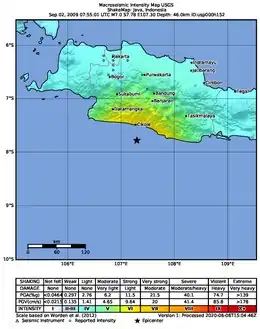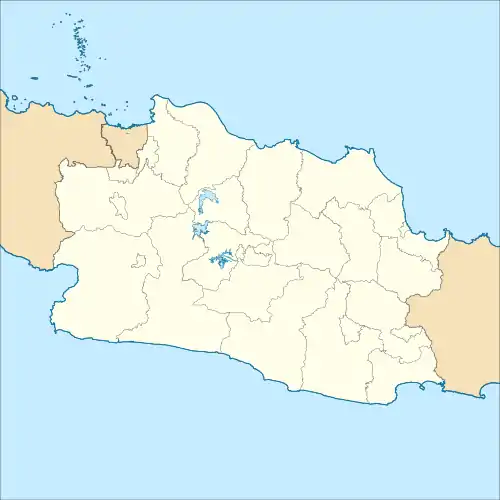 | |
  | |
| UTC time | 2009-09-02 07:55:01 |
|---|---|
| ISC event | 15161670 |
| USGS-ANSS | ComCat |
| Local date | 2 September 2009 |
| Local time | 14:55:01 WIB |
| Magnitude | 7.0 Mw[1] |
| Depth | 49 km (30 mi) |
| Epicenter | 7°46′55″S 107°17′49″E / 7.782°S 107.297°E |
| Areas affected | Indonesia |
| Max. intensity | VII (Very strong) |
| Tsunami | 20 cm |
| Casualties | 81 dead 1,297 injured 210,000 displaced |
An earthquake occurred on September 2, 2009 at 14:55:01 local time in West Java, Indonesia.[1] The magnitude 7.0 earthquake killed at least 81 people, injured over 1,297, and displaced over 210,000 (including more than 140,000 in Tasikmalaya regency).[2][3] The quake was felt in the capital Jakarta, although damage there was minimal, and it was Indonesia's deadliest earthquake since the 2006 Pangandaran earthquake and tsunami.[4]
Cause
The earthquake's focus lies close to the major fault plane where the Indo-Australian Plate is being subducted beneath the Eurasian Plate. However, the focal mechanisms determined for this event shows reverse faulting at a high angle to the trend of the subduction zone and it has been suggested that the cause was deformation within the descending slab.[1] Analysis of GPS data, tsunami run-ups and the effect of stress transfer compared to aftershock distribution supports a west-dipping reverse fault.[5]
Another earthquake in the same subduction zone occurred only 5 days later in the ocean south of Yogyakarta. This newer quake (magnitude 6.2)[6] is considered to be related to the West Java earthquake.[7]
Damage
Buildings in Bandung and Tasikmalaya, the town closest to the epicenter, were damaged, and hundreds of people were injured.[8] An estimated 18,300 homes and offices were earlier thought to have been damaged. This figure later rose to 87,000.
The quake was felt in Jakarta, Indonesia's capital;[9] causing evacuation in many office buildings and hotels. Several office buildings along major thoroughfares in Central Jakarta suffered damage.
At least 11 houses were covered by a landslide in Cianjur.[10]
Around 37 inhabitants, including 13 children, of Cikangkareng were affected by a landslide caused by the quake and are thought to have been buried beneath rubble.[11] The area has become a breeding ground for voyeurs who are flocking to the area to take photographs of the destruction and victims.[12]
At least one hospital was destroyed by the quake.[13]
Victims
Confirmed death tolls by area were issued by The Jakarta Post on 4 September.[14]
| Area | Total |
|---|---|
| Cianjur | 21[14] |
| Garut | 10[14] |
| Tasikmalaya | 9[14] |
| Bandung | 8[14] |
| Ciamis | At least 1[14] |
| Sukabumi | At least 1[14] |
| Bogor | At least 1[14] |
| West Bandung | At least 1[10]
The Bandung Health Agency says nearby victims of the quake will be eligible for free medical treatment for at least a month.[15] Rescuers have been equipped with machinery but are struggling.[16] 34 doctors and 52 paramedics were sent to at least 12 districts.[15] More than 25,000 affected people were housed in makeshift tents.[13] A group of 30 volunteers comprising Malaysian medical students from several universities in Indonesia, headed by Malaysian Students Department director in Indonesia Dr Junaidi Abu Bakar were deployed to provide assistance. They provided food and clothing as well as meals for the breaking of fast.[17] |
See also
References
- 1 2 3 ANSS, "Java 2009: M 7.0 - Java, Indonesia", Comprehensive Catalog, U.S. Geological Survey, retrieved 2 October 2018
- ↑ "Korban Tewas Akibat Gempa Sudah 79 Orang" Kompas newspaper, Sept 8, 2009
- ↑ "KATALOG GEMPABUMI SIGNIFIKAN DAN MERUSAK 1821-2017" (PDF) (in Indonesian). BMKG. Retrieved October 16, 2022.
- ↑ "Indonesian Quake Death Toll Reaches 64 as Rescue Work Continues". Bloomberg. 2009-09-04. Retrieved 2009-09-04.
- ↑ Gunawan, E.; Widiyantoro, S.; Marliyani, G.I.; Sunarti, E.; Ida, R.; Gusman, A.R. (2019). "Fault source of the 2 September 2009 Mw 6.8 Tasikmalaya intraslab earthquake, Indonesia: Analysis from GPS data inversion, tsunami height simulation, and stress transfer". Physics of the Earth and Planetary Interiors. 291: 54–61. Bibcode:2019PEPI..291...54G. doi:10.1016/j.pepi.2019.04.004. S2CID 155851594.
- ↑ "Magnitude 6.2 - SOUTH OF JAVA, INDONESIA". Archived from the original on 2009-09-10. Retrieved 2009-09-10.
- ↑ "KOMPAS.com - Gempa Yogyakarta Terkait dengan Gempa di Jawa Barat". Archived from the original on 2009-09-11. Retrieved 2009-09-10.
- ↑ Staff (September 2, 2009) "Strong earthquake strikes Indonesia's Java island". The China Post.
- ↑ "Deadly earthquake hits Indonesia". BBC News. September 2, 2009. Archived from the original on 2 September 2009. Retrieved 2 September 2009.
- 1 2 "Search on for trapped Indonesians". CNN. September 4, 2009. Retrieved 2009-09-04.
- ↑ CBC News (September 4, 2009). "Indonesian quake death toll rises to 63". CBC. Retrieved 2009-09-04.
- ↑ Asprihanto, Heru (September 4, 2009). "Indonesia quake landslide attracts voyeurs". The Washington Post. Retrieved 2009-09-04.
- 1 2 "Over 25, 000 Indonesian quake-affected people live in makeshift tents". Xinhua News Agency. September 4, 2009. Archived from the original on November 2, 2012. Retrieved 2009-09-04.
- 1 2 3 4 5 6 7 8 Erwida Maulia (September 4, 2009). "Aftershock and aid follow earthquake". The Jakarta Post. Archived from the original on 5 September 2009. Retrieved 2009-09-04.
- 1 2 "Bandung Health agency provides free medical treatment for Java quake victims". The Jakarta Post. 2009-09-04. Archived from the original on 2009-09-05. Retrieved 2009-09-04.
- ↑ "Death toll of Indonesia's quake reaches to 63". Xinhua News Agency. September 4, 2009. Archived from the original on September 7, 2009. Retrieved 2009-09-04.
- ↑ "Malaysian medical students help in Indonesian quake". Archived from the original on 2012-10-10. Retrieved 2013-05-12.
External links
- Death toll rises in Indonesia quake – video from Al Jazeera
- 7.0 Magnitude Earthquake Rattles Indonesia – video from the Associated Press
- Photos at the Toronto Sun
- The International Seismological Centre has a bibliography and/or authoritative data for this event.
- ReliefWeb's main page for this event.